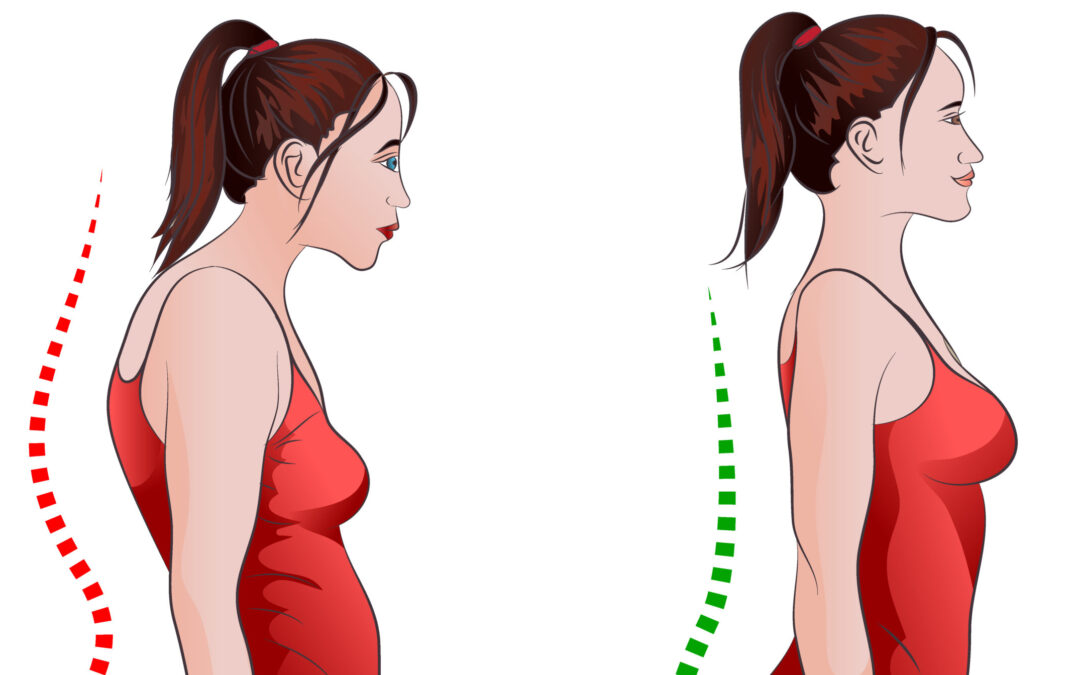What is forward head posture and why is it important to understand? Last week I had several people come into my office with neck and shoulder pain. They ranged in age from mid-thirties to seventies. Each person was different and did different things; however, the result was the same for all of them: their chin was out in front of their chest. Unfortunately, this posture will lead to neck and shoulder pain that radiates down between the shoulder blades.
What Causes Forward Head Posture to Happen?
Obviously, it is about poor posture, as most health care practitioners will tell you. The causes are all over the place and can include weak muscles, a bad chair, heavy backpacks and purses, bad habits, or even poor eyesight. All of these can be true and changing them will help. The bigger problem arises when the professional begins working with the patient. Since the pain is routinely on the backside of the body, most professionals will focus on where the pain occurs. If they believe it is weak muscles, you may be asked to do back-strengthening exercises. Bad chairs need to be replaced by chairs that better support your back or allow you to sit in a different position, which could then lead to problems in other areas. Heavy backpacks and purses can be changed for ones less heavy. Bad habits are more difficult to overcome since the patient must do the work. Poor eyesight can often be easily fixed by getting new eyeglasses.
Again, all these things can be reasons for your forward head posture, but they are not the real cause. The true cause is on the front side of your body. By sitting in front of a computer, looking down at your cell phone, driving a car, writing letters, and just living everyday life, your chest muscles will shorten from use, especially the outside chest muscles. Once the outside chest muscles shorten, the muscles on the front of the neck will shorten, too. When these two things happen, the head shifts forward, increasing the pressure on the back of the neck and down between the shoulder blades.
Your head weighs 10-12 lbs., and for every inch, it leans forward, the pressure increases by 10 pounds. That is a lot of weight at the base of your neck and down your spine. The longer you remain in that position, the worse it gets. Employing ergonomics can be helpful, like having a properly sized chair, having a stand-up desk, or placing the monitor or TV in the correct position. However, if you don’t lengthen the chest and front neck muscles, it will not matter much.
How to Solve this Problem
If you want to prevent or reverse forward head posture, we want to first soften the chest muscles by using our hands. Stand next to a wall and place your right forearm on the wall for support. Next, use your left hand to gently squeeze the outside chest muscle that runs from your upper arm down into your chest. As you squeeze the muscle, feel for sore spots. Take your time here so you can learn how to feel your own body. When you find a spot that is sore, stay there, maintain the pressure, breathe out, and allow the muscle to relax until the pain stops. Once the pain stops, move to another spot and repeat. To soften the larger inside chest muscles, use the fingers of your left hand and feel in between your ribs. Start at the breastbone and slide out toward your upper arm, staying in between the ribs. Do not push hard. Give yourself time to feel as you slowly glide through the ribs to find sore spots. Again, once you find such a spot, stay there, maintain the pressure, breathe out, and allow the muscle to relax until the pain goes away. Be sure to do both sides and do this throughout your day to maintain soft muscles. Since you are not pushing hard, there will be no soreness, and you will not overdo it.
Now you are ready to stretch the chest and front of your neck. Follow the videos below to help guide you through the stretches. I would suggest doing them each morning and evening to maintain freedom of movement and prevent forward head posture.
A Book Recommendation
Everyone who has read my articles or heard me speak knows that I speak about the power of the brain in relation to your muscles. My wife and I found a great book about how the brain affects so many chronic illnesses people suffer. While this book is mainly about vertigo and tinnitus, the process of changing your brain through neural plasticity will help anyone suffering from chronic pain.
The book, Rock Steady, is by Joey Remenyi, and it will teach you how to do body scans to get a better understanding of your body and how the brain plays a major role in resolving your pain. It is available on Amazon and Kindle.
Best Practices for Stretching
All you need is a yoga strap and a tennis ball for the tennis ball massage. Give yourself about 15 minutes twice a day and you should see better results within 2 weeks. This, though, is a lifetime event. Think of your pet. they stretch every day and several times a day. Stretch when they stretch. Follow the videos below and free your knees. In my opinion, the calf stretch is the most important stretch a human can do. It will solve many issues of the body.
Stretching is more about feeling the muscles letting go than forcing them to stretch. If you are forcing the muscle, you could be doing strength training, not stretching. Make sure you are feeling the intended muscle stretching. If not, the form could be wrong. Holding for 5 seconds allows the brain to release the muscle before it senses any danger. Repeating the stretches 10 times allows the brain to learn it is safe for the muscle to move that way.
Don’t forget the Tennis Ball Massage!
Softening your hips and back is easy when you use the tennis ball. Just lean against the wall and apply enough pressure to feel the painful area. The temptation is to press harder but resist it. Instead, breathe out and allow the muscle to soften under the ball. Then move to another spot and repeat. Continue doing this until most of the painful spots are gone. Check out previous newsletters to see the video.
If you like this newsletter, please share it with your friends and family. Don’t forget to check out our social media pages, leave a comment, and as always, reviews are awesome!
Want to Talk with Me Directly? Start Here
We’re happy to offer you a complimentary 30-min virtual consultation so you can experience this for yourself. Schedule your introduction to Stretch n Release now.
About The Muscle Repair Shop
Drawing upon his personal experience as a former competitive athlete turned wheelchair, obese, and chronic pain sufferer, Muscle Repair Shop Founder Butch Phelps decided to take his health into his own hands when at the age of 36 he was told he might not make it to his 40th birthday. Applying balanced nutrition advice from his doctor along with a sound exercise program, he went from 315 lbs. to 180 lbs. Motivated by his experience, he then acquired degrees in advanced therapeutic massage and aging sciences to help people eliminate chronic pain. This included applying his expertise in how people age, including the effects of dementia, anatomy, psychology, and the day-to-day struggles living as an older person to his practice and development of The Muscle Repair Shop’s one-of-a-kind Stretch n’ Release Technique.
Available through in-office and virtual coaching treatment sessions, this unique combination of stretching and breath work teaches the brain to release the emotional side of muscle tension and pain allows clients to find lasting relief and healing from stiffness, aches, injuries, and chronic pain. The at-home exercises come with customized instructional videos and virtual or in-office support, allowing clients to enjoy and experience life and sports as they did before limitations slowed or curtailed activities.


